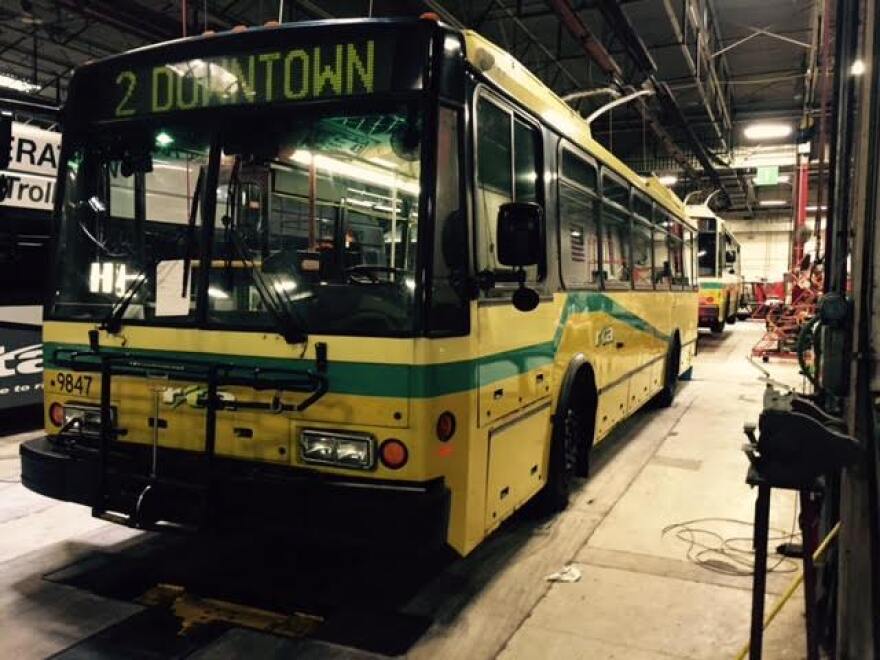Dayton is one of only five US cities that still have electric trolley buses. Listener Aaron Hill had several questions about the trolleys: he wondered about their history, their cost compared to diesel buses, and the future of the trolley system. I drove down to RTA headquarters in Dayton and sat down with two veteran employees to find the answers to our curious listener’s multiple-part question.
How did Dayton get its trolleys?
Pubic transportation in Dayton goes all the way back to 1870. Pat O’Malley, the RTA’s bus fleet director, says, “In Oakwood there were horses and carriages pulling the streetcars.”
In 1888, electric streetcars replaced horses, and in 1933 rubber-tired trolley buses replaced streetcars.
According to O’Malley, the city didn’t always own the trolleys. Each line used to be owned by a different company. City Transit, which eventually became a part of the RTA, bought these companies as they went out of business during the 1950s.
Who bought all those trolley lines? That would be W. W. Owens, the director of City Transit at the time. Owens was a major advocate for public transportation, and he’s so respected within the RTA that neither of the employees I talked to even knew his first name.
“I just knew him as Mr. Owens,” says Keith Rihm, who’s worked as a trolley repair specialist for 26 years. “I know he’s buried in Woodland Cemetery; there’s a trolley on his gravestone.”
Owens’ actions are probably why Dayton still has trolley buses; Pat O’Malley explains there are only four other US cities left with them: Philadelphia, Boston, Seattle, and San Francisco. “And of course Dayton, Ohio,” he adds.
How much money to trolleys save?
The RTA estimates the electricity cost for trolleys at a little less than 40 cents per mile. Those electricity prices stay much more constant than the price of gas, so to do a cost comparison to diesel fuel, I did some outside research.
According to the energy information administration, the average price of diesel is $2.32 per gallon. O’Malley told me the diesel buses get between four and five miles per gallon, so they cost about 51 cents per mile. That means trolleys are ten cents cheaper per mile, right?
Actually, it’s not quite so simple. The maintenance costs for trolleys are higher than buses, since the trolleys are 16 years old.
“They were built part here, and part out of Czechoslovakia by a company called Skoda,” O’Malley says. “They no longer build a transit bus, so parts are very hard to find for them.”

And finding parts isn’t the only frustrating maintenance problem. Keith Rihm opens a hatch in the side of a trolley and shows me what he calls his “wiring nightmare.” Hundreds of closely-packed wires connect to every part of the bus.
How do you find the problem in this mess of wires? “The easiest thing to do is to see what’s burnt up,” says Rihm.
If you factor in the specialized labor costs needed to repair the trolleys, their cost isn’t that different from the diesel buses. But that leads us into our final question.
What’s the future of the trolley lines?
The RTA plans to roll out a new fleet of trolleys in the next two years. They’ll be under warranty, so repairs will be much cheaper. And on the new trolleys, finding out what’s wrong with the wiring will be done by cracking open a laptop.
Learn more:
Here's a history of public transportation in Dayton.
And here are route maps going all the way back to 1932.
WYSO Curious is our occasional series about your questions and curiosities—let us know what you are curious about in the Miami Valley, and your question could get answered by a WYSO reporter. WYSO Curious is a partnership with Hearken, founded by Jennifer Brandel based on her work at Curious City/WBEZ Chicago.
_






